
Peter van Boucle [1] (between 1600 en 1610 (?), probably Antwerp - 1673, Paris) was a Flemish Baroque painter who worked for a large part of his life in Paris where he was one of the most prolific Flemish still life painters. [2]

Peter van Boucle [1] (between 1600 en 1610 (?), probably Antwerp - 1673, Paris) was a Flemish Baroque painter who worked for a large part of his life in Paris where he was one of the most prolific Flemish still life painters. [2]
There is little information available about the life and training of Peter van Boucle. He claimed that he was a pupil of Frans Snyders but there are no written sources available in Antwerp that support this contention. However, there are stylistic similarities in his works which suggest that he worked in the vicinity of Frans Snijders. [3]

Van Boucle's father Carel was an engraver, who had become a master in the Guild of St. Luke of Antwerp in 1603 and emigrated to Paris in 1617. [4] Peter van Boucle was registered with his father in Paris in 1623. At that time many Flemish artists were active in the Parisian district of Saint-Germain des-Près. [5]

He worked for a while with the still life painter Lubin Baugin in the studio of Simon Vouet. Here they made designs for tapestries (which have not been located). He probably also was familiar with the still life painters Jacques Linard and Louise Moillon, since his work shows affinities with theirs. [6]
According to the early French biographer Florent le Comte he died in misery because of his dissolute life despite his success as an artist. [4]
Van Boucle signed his works with the initials PVB and his works are therefore sometimes confused with those of other artists such as Pieter van den Bos and Peeter van den Bemden. [4] [7]
Van Boucle mainly painted still lifes and paintings of animals. He is considered one of the best Flemish animal painters, together with Pieter Boel and Nicasius Bernaerts. [6] Van Boucle often animated his still life compositions with cats and dogs, much like his master Frans Snyders. [2] He worked for several patrons, including nobles and courtiers as well as hop keepers alike. His works are now mostly in private collections. [6]

Van Boucle painted many works that allude to wealth and luxury. These elements are visible in his still lifes, which show the luster of fruits and vegetables that contrast with the glow of jewelry, silverware and other objects. He was very adept at representing the smoothness of Chinese porcelain that is often present in his paintings.
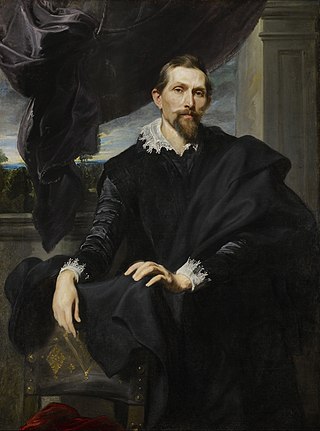
Frans Snyders or Frans Snijders was a Flemish painter of animals, hunting scenes, market scenes, and still lifes. He was one of the earliest specialist animaliers and he is credited with initiating a wide variety of new still-life and animal subjects in Antwerp. He was a regular collaborator with leading Antwerp painters such as Peter Paul Rubens, Anthony van Dyck, and Jacob Jordaens.
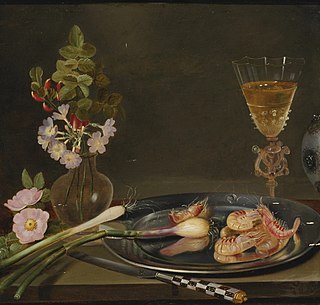
Frans Ykens was a Flemish still life painter active in Antwerp and Brussels in the 17th century. He is mainly known for his flower pieces and fruit still lifes and also painted banquet pieces, pronkstillevens, garland paintings and larger game pieces.

Pieter Boel or Peeter Boel was a Flemish painter, printmaker and tapestry designer. He specialised in lavish still lifes and animal paintings. He moved to Paris, where he worked in the gobelin factory and became a painter to the king. Pieter Boel revolutionized animal painting by working directly from live animals in a natural setting. He thus arrived at representations of animals showing them in their natural, characteristic poses. He had many followers in France.
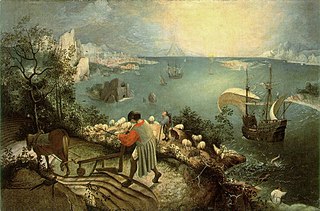
Dutch and Flemish Renaissance painting represents the 16th-century response to Italian Renaissance art in the Low Countries, as well as many continuities with the preceding Early Netherlandish painting. The period spans from the Antwerp Mannerists and Hieronymus Bosch at the start of the 16th century to the late Northern Mannerists such as Hendrik Goltzius and Joachim Wtewael at the end. Artists drew on both the recent innovations of Italian painting and the local traditions of the Early Netherlandish artists.

Pieter van Bloemen, also known as Standaart, first name also spelled Peter or Peeter, was a Flemish painter. He was a gifted landscape and animal painter and was very successful with his compositions depicting equestrian, animal and market scenes.

Simon de Vos was a Flemish painter, draughtsman and art collector. He started his career making small-format cabinet pictures of genre scenes, in particular of Caravaggesque merry companies. Later he switched to history painting, working on larger formats in a Flemish Baroque style which was influenced by Rubens and van Dyck.
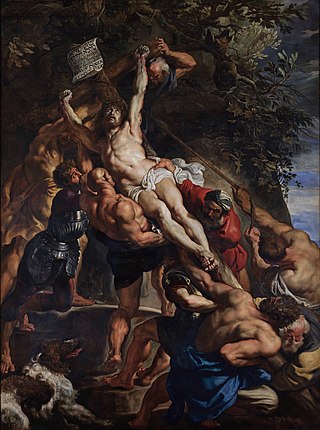
Flemish Baroque painting was a style of painting in the Southern Netherlands during Spanish control in the 16th and 17th centuries. The period roughly begins when the Dutch Republic was split from the Habsburg Spain regions to the south with the Spanish recapturing of Antwerp in 1585 and goes until about 1700, when Spanish Habsburg authority ended with the death of King Charles II. Antwerp, home to the prominent artists Peter Paul Rubens, Anthony van Dyck, and Jacob Jordaens, was the artistic nexus, while other notable cities include Brussels and Ghent.

Frans Francken the Younger was a Flemish painter and the best-known and most prolific member of the large Francken family of artists. Francken painted a range of subjects, producing large altarpieces for churches as well as smaller historical, mythological and allegorical scenes. His depictions of collectors' cabinets established a popular new genre of art in the era. Francken often collaborated with other artists, adding figures and narrative elements to scenes created by specialists in landscape, architectural scenes, and floral still life painting..
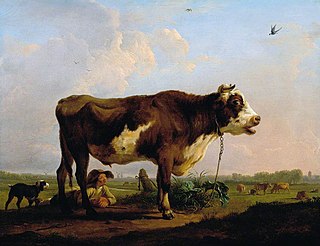
Balthasar Paul Ommeganck (1755–1826) was a Flemish painter of landscapes and animals active in Antwerp. Through his work and his role as an art teacher and founder of art institutions he gave an important impetus to the revitalization of landscape painting in the Low Countries.

Pieter van Mol or Peter van Mol was a Flemish painter known for his history paintings of religious subject matter, and to a lesser extent for his allegorical compositions, genre scenes and portraits. His style was profoundly influenced by Rubens, Abraham Janssens and Artus Wolffort. He was court painter to the King and Queen of France.

Pieter Faes or Peeter Faes was a Flemish painter of still lifes of flowers and fruit. He worked in a decorative style close to that of Jan van Huysum.

Jan Baptist Bosschaert or Jan Baptist Bosschaert the Younger was a Flemish still life painter who is principally known for his decorative still lifes with flowers. He collaborated with figure artists on compositions which combined allegorical or mythological scenes with a still life element. He was active in Antwerp.

Gaspar Peeter Verbruggen or Gasparo Pedro Verbruggen was a Flemish still life painter who is principally known for his decorative still lifes with flowers and fruit. He collaborated with figure artists on compositions which combined figures with a still life element. He was active in Antwerp and The Hague.
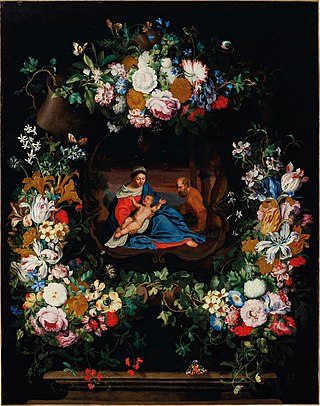
Jan Pieter Brueghel or Jan Peeter Brueghel was a Flemish painter who specialised in flower still lifes and garland paintings. A scion of the famous Brueghel family of painters, he trained in Antwerp with his father and later worked in Liège, Paris and Italy.

Peeter Gijsels or Pieter Gijsels, was a Flemish Baroque painter. He is known for his landscapes, architectural compositions and still lifes. His landscapes in the style of Jan Brueghel the Elder were very sought after in his time. He is also regarded as a genre painter as he painted village scenes of village markets and kermises.

Peter Ykens, was a Flemish painter mainly known for his history paintings and portraits. He regularly collaborated with specialist still painters and landscape artists for whose works he provided the staffage.
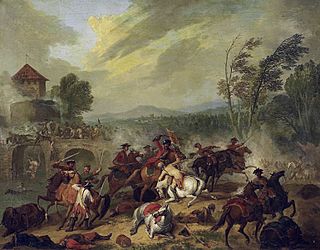
Jan Peeter Verdussen or Jan Pieter Verdussen was a Flemish painter, draftsman and printmaker. He is known mainly for his battle scenes, incidents of camp life and equestrian paintings. He also painted landscapes with hunting scenes, gallant companies and genre scenes of markets.

Jan Peeter van Bredael the Elder or Jan Pieter van Bredael the Elder was a Flemish painter, art restorer and art dealer. He is known for his still lifes of flowers and fruits, game and Italianate landscapes. He was a member of the prominent artistic family van Bredael from Antwerp.

Pieter Hardimé was a Flemish painter known for his paintings of flowers. He trained in Antwerp and later moved to the Dutch Republic where he worked in The Hague. He was active as a decorative painter of flowers for wall and ceiling decorations, often in collaboration with Mattheus Terwesten.

Peeter van den Bemden, known also as Pieter van den Bemden and Peeter van den Bemde was a Flemish still life painter active in Antwerp who is known for his still lifes of dead game, birds and fish and large kitchen still lifes. His work shows a close relationship with works of other Antwerp painters of similar subjects such as Peter van Boucle, a Flemish still life painter who was active in Antwerp from the mid-1630s.